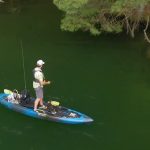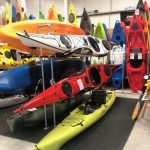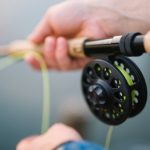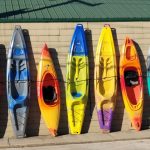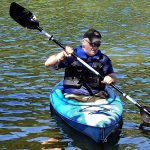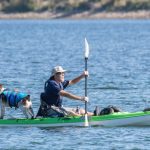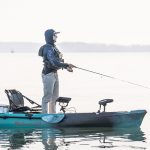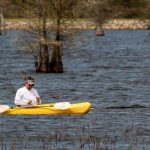Pedal kayak models have exploded in the recent years. The ability to go faster with less fatigue and have your hands free for fishing is hard to pass on. In this article, we review pedal kayak models that we think will dominate the market in 2021.
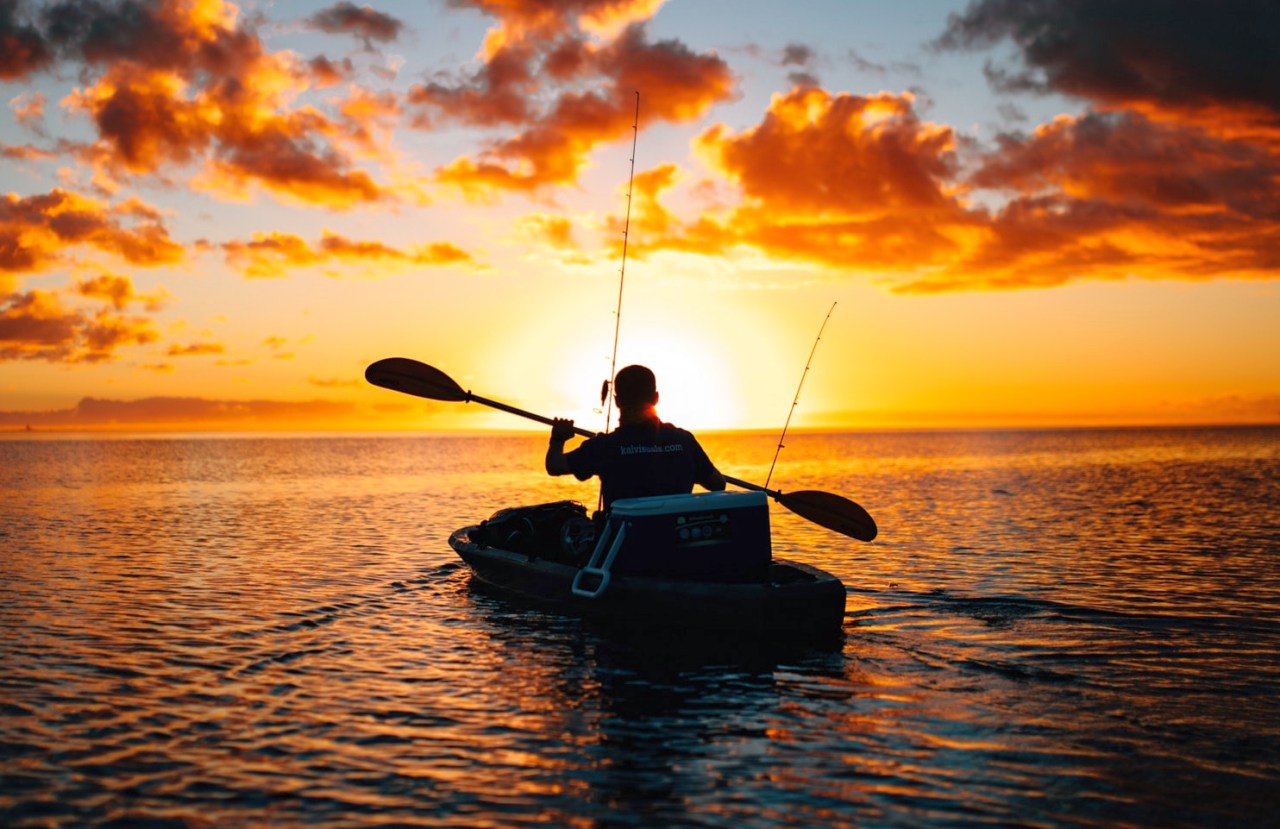
In a hurry? Our pick for the Best Ocean Fishing Kayak is Old Town BigWater 132 PDL
Kayak fishing has become much more popular over the past two decades. Although most kayak anglers stick to inshore waters such as lakes and rivers, more and more brave souls venture into open waters in their kayaks.
In this article, we’ll look at the best ocean fishing kayaks, the differences between popular models, and factors to consider before making a purchase.
As an affiliate of Amazon and other retailers, we may earn a small commission when you buy via our links, at no additional cost to you. Thank you!
Quick Answer: Best Ocean Fishing Kayaks
- Best Overall: Old Town BigWater 132 PDL
- Best Value: Old Town Sportsman Salty PDL 120
- Best Premium: Hobie Pro Angler 14
- Best Motorized: Old Town Sportsman AutoPilot 136
- Jackson Knarr
- Wilderness Systems Radar 135
- Native Slayer Propel 12.5
Comparison Table: Best Ocean Fishing Kayaks
| Model | Specs | Where To Buy |
Old Town BigWater 132 PDL | Size: 13′ 2″ x 36″ Weight: 96 lbs Capacity: 383 lbs | Eco Fishing Shop |
Old Town Sportsman Salty PDL 120 | Size: 12′ x 34.5″ Weight: 85 lbs Capacity: 346 lbs | Amazon |
Hobie Pro Angler 14 | Size: 13′ 8″ x 38″ Weight: 124.5 lbs Capacity: 600 lbs | Eco Fishing Shop |
Old Town Sportsman AutoPilot 136 | Size: 13′ 6″ x 37″ Weight: 158 lbs Capacity: 502 lbs | Amazon |
Jackson Knarr | Size: 13′ 9″ x 37″ Weight: 140 lbs Capacity: 475 lbs | Eco Fishing Shop |
Wilderness Systems Radar 135 | Size: 13′ 6″ x 34″ Weight: 90 lbs Capacity: 475 lbs | Amazon |
Native Slayer Propel 12.5 | Size: 12′ 6″ x 34″ Weight: 125 lbs Capacity: 500 lbs | FishUSA |
Best Ocean Fishing Kayaks Reviewed
Best Overall: Old Town BigWater 132 PDL

Length: 13′ 2″ (403.8 cm)
Width: 36″ (91.4)
Weight: 96 lbs (43.5 kg)
Capacity: 383 lbs (173.7 kg)
What we like: The unique drive system has built in storage and is easily stowed upright when launching/landing. At a little over 13’ long, this kayak is extremely stable while still being easy to paddle by hand.
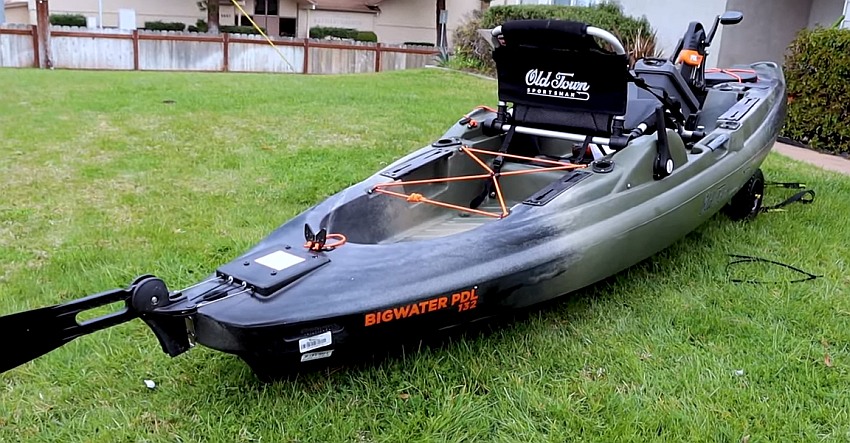
Plenty of gear tracks forward and in the stern makes accessorizing a breeze. Wide, non-slip deck pads provide good standing space.
What we don’t like: A relatively small, single hatch located in the bow limits internal storage options. This means most of your gear is going to have to go into the well behind the seat and will need to be secured properly. One spill in this and you might lose most of your gear.
Best Value: Old Town Sportsman Salty PDL 120

Length: 12′ (365.7 cm)
Width: 34.5″ (87.6 cm)
Weight: 85 lbs (38.5 kg)
Capacity: 346 lbs (157 kg)
What we like: The cost on this one is great, especially for an angler who’s never owned an ocean going kayak with a pedal drive. At $2449 MSRP, there’s really nothing else on the market comparable to it.
What we don’t: It’s small. I personally think that 12’ is too short for something you’re planning to take into the ocean or paddle long distances. Strong ocean currents and swells will make this track poorly should you ever have to paddle by hand.
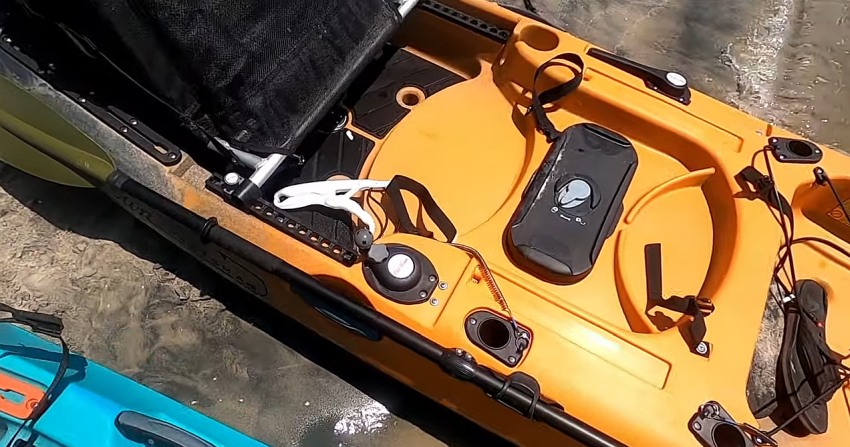
Unfortunately by limiting the overall size, the internal storage got eliminated, so everything must be strapped to the deck.
Best Premium: Hobie Pro Angler 14

Length: 13′ 8″ (416.5 cm)
Width: 38″ (96.5 cm)
Weight: 124.5 lbs (56.5 kg)
Capacity: 600 lbs (272 kg), 350 lbs (158.7 kg) seat
What we like: As far as stable fishing platforms go, the Pro Angler takes the cake. Its hull design makes for a wide, tall, and stable option for kayak anglers with the best weight capacity around. With it being so big, it also features a wide, open deck.
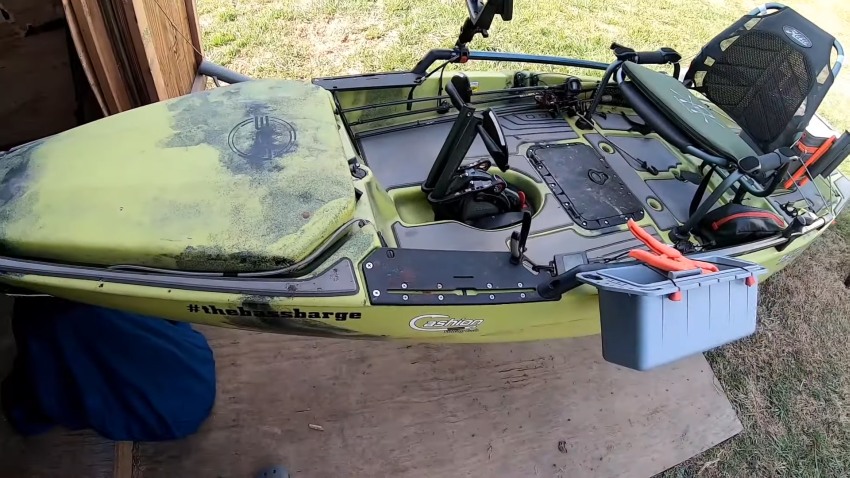
Hobie has led the pedal drive world for years. Their 360 Mirage Drive is simply awesome. The technology allows anglers to move the kayak any direction while fighting big fish, not just forward and backwards.
Couple that in with the kick-up fins that avoid below water hazards and it’s clear that this is the best pedal system on the market.
What we don’t like: *queue cash register noises* The Pro Angler 14 isn’t cheap. Base model before adding more gear is $5799 which can be daunting for someone looking to get into ocean fishing from a plastic boat.
This is a heavy kayak, plain and simple. All the features that have gone into them, added stability, and weight capacity makes these one of the heaviest non-motorized sit on top kayaks on the market.
If you have to move these any distance to launch, I strongly recommend purchasing a cart. This, of course, adds to the cost.
Best Motorized: Old Town Sportsman AutoPilot 136

Length: 13′ 6″ (411.5 cm)
Width: 37″ (94 cm)
Weight: 158 lbs (71.7 kg)
Capacity: 502 lbs (227.7 kg)
What we like: Another big, wide kayak, the Sportsman AutoPilot 136 is quite stable with great weight capacity. Since there’s no pedal drive in the way, this motorized kayak has a ton of open deck space.
Minn Kota makes some of the best trolling motors in the world, and this is where these kayaks shine. They’re powered by a 45 lb thrust Minn Kota electric motor with spot-lock and I-Pilot.
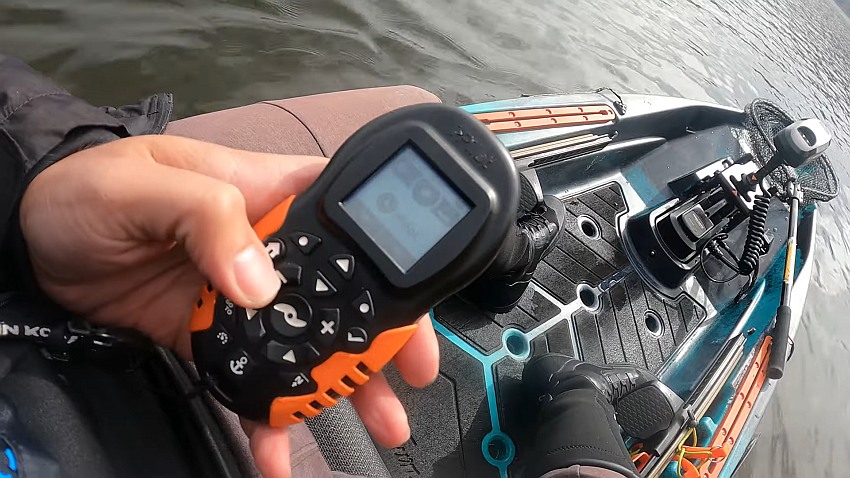
Spot lock works with GPS to hold the boat in place without the use of a traditional anchor. Simply hit the anchor button, and the motor will automatically adjust itself to keep you in place. This is a huge advantage if you’re trying to stay floating over a deep water reef.
What we don’t like: This is the heaviest kayak I’ve personally ever seen and that’s before throwing in a 12V battery and fishing gear. That’s a lot of boat to drag down to the beach or try to paddle back should the battery die.
Honorable Mentions
Jackson Knarr

Length: 13′ 9″ (419 cm)
Width: 37″ (94 cm)
Weight: 140 lbs (63.5 kg)
Capacity: 475 lbs (215.5 kg)
What we like: With a hull design specifically made to handle rough seas and ocean currents, the Jackson Knarr is a great option for an ocean fishing kayak. It has plenty of storage and stability to stay out all day and travel those long distances to find fish.
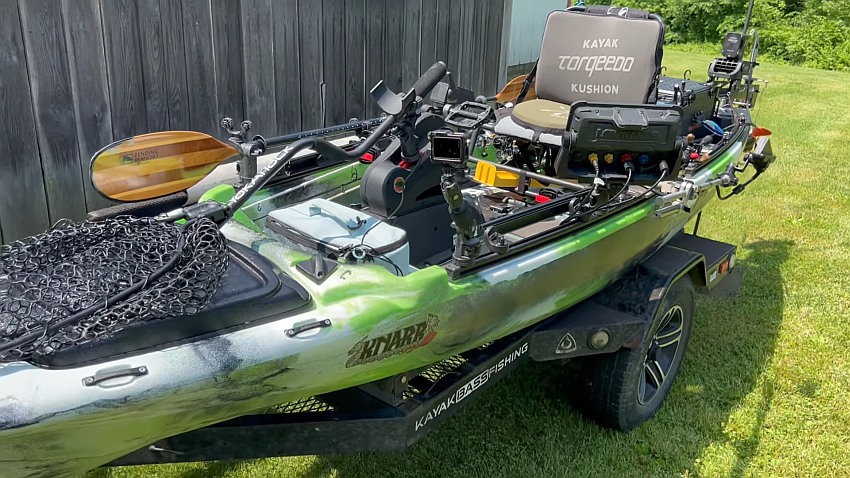
What we don’t like: Unfortunately this boat comes with the option for a lot of great fishing features and seems to be a “Jack of all trades, master of none” style. It only comes with two rod holders and if you’d like to carry more fishing rods safely, you’ll need to purchase extra equipment.
Other features include a flat mounting space for a trolling motor, a bait tank scupper for a live well, and gear tracks specifically for YakAttack mounts. These options are great, but if you don’t plan to use any of these things, I feel as though it’s a waste of design space, weight, and cost.
Wilderness Systems Radar 135

Length: 13′ 6″ (411.5 cm)
Width: 34″ (86.4 cm)
Weight: 90 lbs (40.8 kg)
Capacity: 475 lbs (215.5 kg)
What we like: Wilderness Systems has been manufacturing some of the fastest sit on top kayaks on the market, and the Radar 135 is no exception. It’s lightweight and sleek design means that it not only tracks well but it flies through the water with ease.
If you’re looking for a fast fishing kayak, look no further.
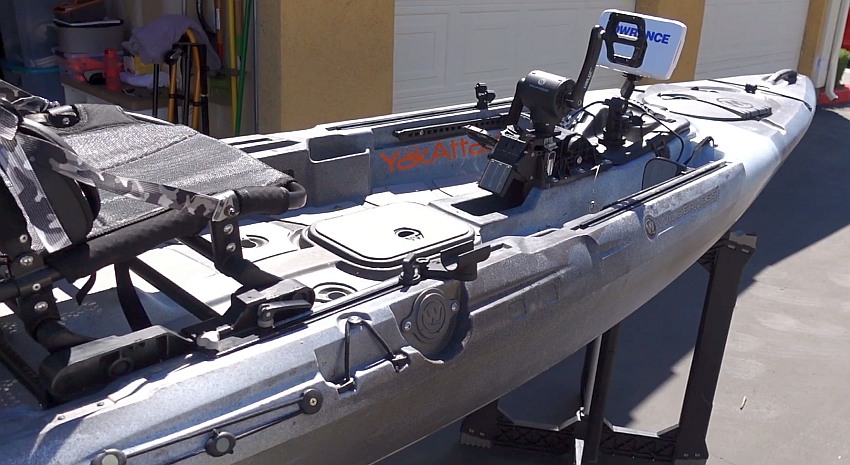
What we don’t like: A sleek, relatively narrow design might not be the best option for beginner paddlers as stability is sacrificed for speed.
The Radar 135 is advertised as a “tri-powered kayak” meaning that you have the option to paddle, pedal, or motorize it. The pedal drive, however, is almost the cost of the kayak alone, with the motor coming in at a hefty $2299.
Native Slayer Propel 12.5

Length: 12′ 6″ (381 cm)
Width: 34″ (15.4 cm)
Weight: 125 lbs (56.7 kg)
Capacity: 500 lbs (226.8 kg)
What we like: For only being 12′ 6″, this kayak has more than enough storage space. A huge front hatch cover gives anglers access to a ton of internal storage, and a very large well behind the seat can hold no shortage of gear. It even has a tackle drawer included under the seat.
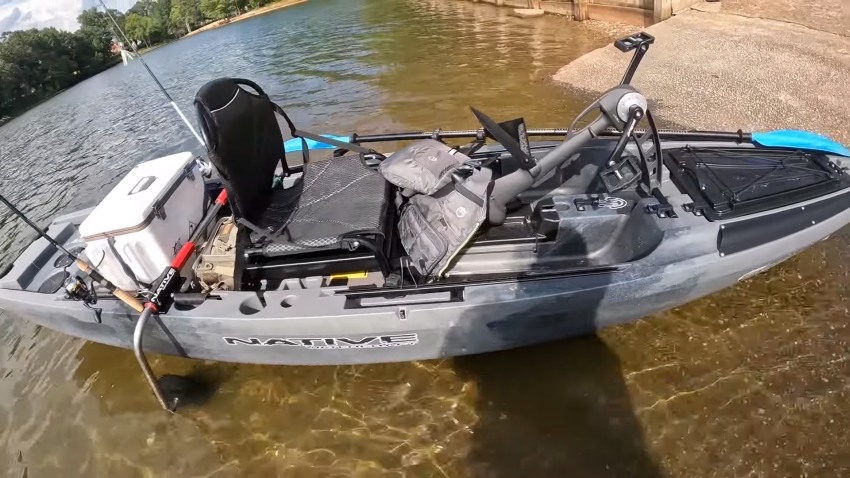
What we don’t like: As far as pedal driven kayaks go, the Slayer Propel 12.5 is low profile. Great for not getting blown around in a stiff breeze, but not so great for handling surf or swells. This kayak seems to have a better home on inland lakes and shallow water flats than out in the ocean.
What Features Make a Good Offshore Fishing Kayak?
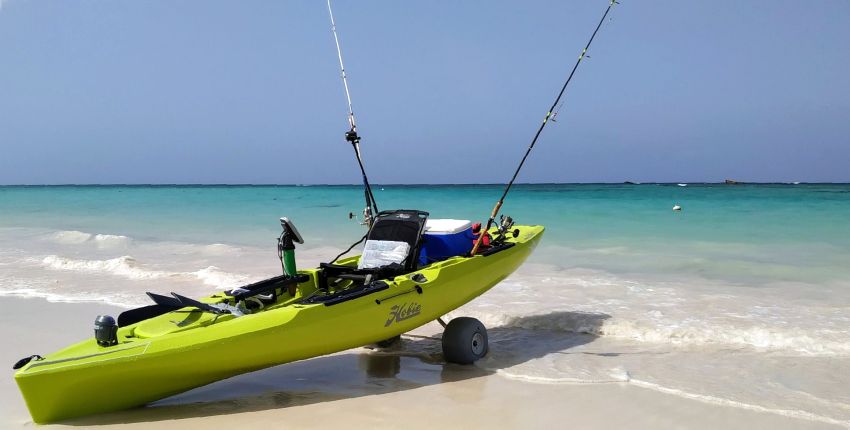
Not all kayaks are created equal. Great saltwater kayaks have several key features that set them apart from other kayak models. Let’s look at these features.
Stability
Typically, the ocean is anything but flat calm. Having an extremely stable kayak can be the difference between a successful fishing trip and a yard sale on the beach.
Hull shape, width/length, and scupper design all play into making a stable sea fishing kayak. Many manufacturers have adopted pontoon-like hull designs with a hard chine. These styles provide excellent stability without sacrificing too much speed.
Hull Width
A kayak’s width is another important factor to consider. Most modern fishing kayaks are quite wide for better stability.
There is, however, a fine line between wide enough and too wide. A kayak that’s too wide will be a nightmare to paddle. I suggest picking a kayak that is 32” to 36” wide.
Kayak Length
12 feet is the minimum length I recommend for an ocean fishing kayak. Shorter kayaks will track terribly in rough waters. If you’re going to paddle long distances, you need a 12 ft or longer kayak.
Capacity and Storage Space
Saltwater fishing usually requires bigger, heavier tackle. Therefore, a good sea fishing kayak should have adequate weight capacity (at least 350 lbs) and sufficient storage space. Having enough room for all your gear will make your fishing trips more enjoyable and safer.
Once on the water, you can’t just get out of the kayak to open a storage hatch. Your kayak needs to have easily accessible storage.
Weight
Weight is one of the biggest issues with modern fishing kayaks. As kayaks get bigger and pack more features, they quickly become heavier and heavier.
Always consider how you will transport the kayak to the water and back. Will you have a fishing buddy to help unload the kayak from your vehicle and then load it back? Will you be able to haul a 120 lb kayak several hundred yards across the sand or rocks?
That said, there are ways to help you deal with the weight of the kayak. Kayak dollies, kayak trailers, and load assist racks can make handling a heavy fishing kayak much easier.
Comfort
Offshore fishing in a kayak involves long hours on the water without the ability to get out and stretch your legs. This means a comfortable seat is crucial. If your lower back is killing you or your legs start falling asleep, you’re not going to enjoy your fishing trip.
Most fishing kayaks these days come with super comfy framed seats. These framed, cushioned seats provide maximum comfort during long days on the water.
Some seats even have low and high settings to help you find an optimal seating position. Sitting higher lets you see into the water and have a drier ride. Sitting lower makes the kayak more stable and less prone to winds.
Accessories
As kayak anglers, we love accessories. A fish finder, rod holders, tackle boxes, coolers, paddle holders; you name it.
A good sea fishing kayak should have plenty or gear tracks, gear mounts, or at least room to add your favorite accessories easily.
Gear tracks along the sides allow for great customization. Bungees, straps, or clips in strategic spots can help strap your gear down. A rudder system (or the ability to add one) can help with maneuverability.
Pro tip: don’t get too many accessories right off the bat. Add them as you go, picking the accessories you actually need. If a kayak has every bell and whistle, but you aren’t using them, then it’s just added weight and wasted money.
Saltwater Kayak Fishing: Paddle, Pedal Drive, or Motor?
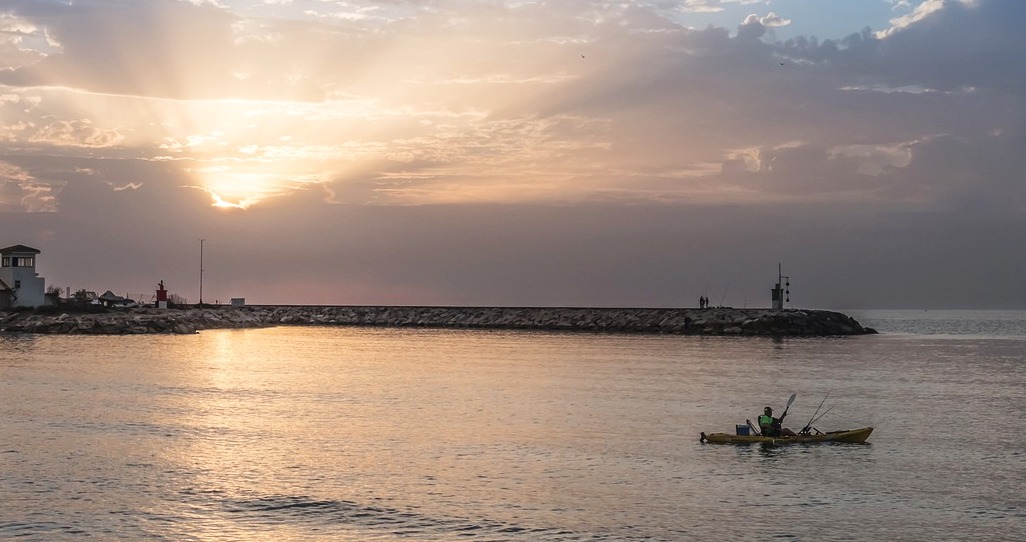
The biggest decision when selecting an ocean fishing kayak is what kind of propulsion to use. There are pros and cons to every method, especially when fishing in the open ocean.
Paddle
Paddling by hand is obviously the cheapest and most “traditional” method for getting a kayak from point A to B. Unlike other methods, there’s not nearly as many moving parts with paddle kayaks so the chances of something breaking are vastly reduced.
The biggest problem with paddling a fishing kayak is that you’re trying to fish and need your hands free. That means picking up and dropping your paddle every time you need to move.
Since most fishing kayaks are quite heavy and bulky, you’ll have more of a workout than a fishing trip.
Pedal Drive
Pedal kayaks have practically taken over the kayak fishing industry in the last two decades. They’re fantastic for fishing because they free up an angler’s hands, allowing them to focus on fishing rather than maneuvering.
Couple that in with the fact that most people are much stronger in their legs than their arms, and it’s no surprise pedal kayaks have become so popular.
There is the argument that a pedal kayak can’t get as shallow as a paddled one, but if we’re talking about ocean fishing, that’s a moot point.
One big thing to consider when selecting a pedal kayak is the reliability of the pedal system. If you’re venturing several miles offshore in search of big game in rough waters, having a good, reliable pedal drive is crucial for safety.
Should your pedal drive break, consider how difficult it will be to paddle several miles back to shore.
Motors
Having a motorized fishing kayak can definitely help to avoid sore muscles after a long day of fishing. Electric trolling motors can be used to propel, steer, and even hold the kayak in a single spot.
The disadvantages to a motorized kayak include extra weight, limited battery life and the cost of modern lithium batteries. A good 100 Amp*hour battery can set you back a cool $900. You’re also looking at extra 50 lbs or more for the motor and the battery combined.
Ocean Kayak Fishing Tips
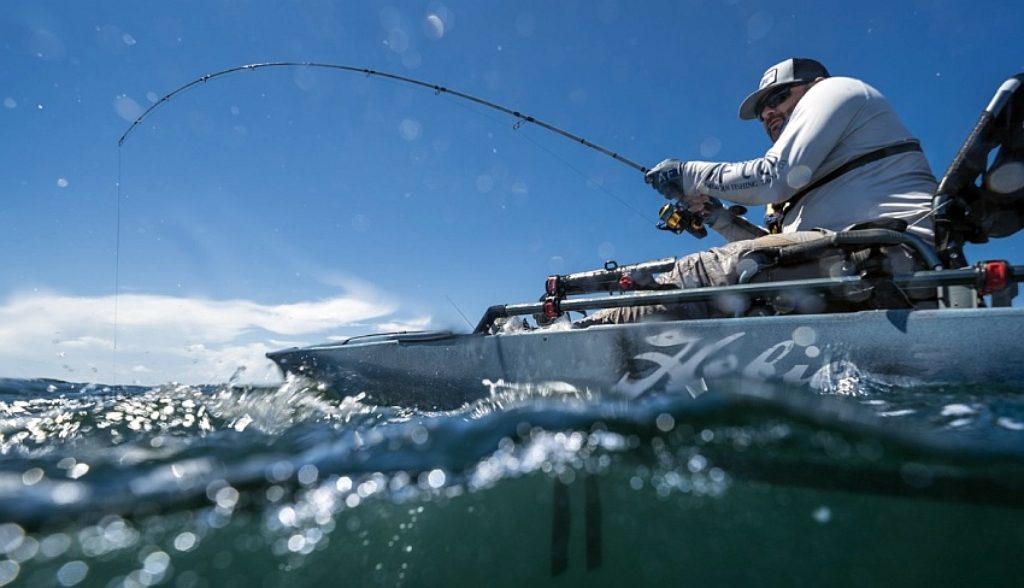
Kayak fishing in the ocean comes with its own unique challenges and issues when compared to fishing inland waters or lakes. Here are some helpful tips to keep in mind when fishing open waters.
Setting Up for Saltwater Fishing
Typically, offshore fishing requires bigger, heavier fishing gear. As space is limited in a fishing kayak, it’s important to make sure things fit.
Early in my kayak fishing career, I found out that my Amberjack rod didn’t fit in the kayak’s rod holder because the rod butt was too big.
So I had to lay the rod in my lap for the entire trip.
Guess where that rod is today?
Somewhere on the bottom of the Gulf of Mexico.
Offshore fishing often means bigger tackle and live bait as well. Many companies sell aftermarket live wells to fit into an ocean kayak. Keep in mind that these add considerable weight as just a 5 gallon livewell will weigh close to 40lbs.
Consider the fishing gear you regularly use. Even if it’s specifically designed for salt water, chances are you aren’t regularly inundating it when fishing from a boat or shore.
From a kayak, however, it’s going to get absolutely soaked. Make sure the gear can handle salt water and clean it thoroughly after each trip.
Dealing With Surf
Launching a fishing kayak in the sea means dealing with the surf. It’s probably the most daunting part of fishing out of an ocean kayak.
As with any fishing trip, be sure to check the weather beforehand. I’ve had no shortage of trips where I show up at the beach, look at the surf, and simply turn around and go home. If it’s too rough, it’s not worth losing gear, or worse, hurting yourself.
Remember too that the surf can build. Just because you can launch smoothly, doesn’t mean coming back is going to be easy. In fact, returning to shore can be far more difficult than leaving because you have to ride the waves in.
The best way to get launched in the surf is to have a friend wade out and help push you head on into the waves. But since that isn’t always an option, wading out yourself (preferably beyond the breakers), and then climbing in works too.
Ocean swells don’t always remain constant so it’s good to make a habit out of watching the surf while you’re busy dragging gear down to the beach. Timed right, you can sneak through in between sets.
Always plan on the kayak to flip. Make sure to strap down everything you’re not willing to lose. Flipping in the surf means the kayak (and you) go for a tumble. If things aren’t secure in the kayak, you’ll quickly be dealing with a yard sale.
Distance
Depending on where in the world you’re doing your offshore fishing, you may have to paddle long distances to find fish. Whether it’s live bottom, an offshore wreck, or even good areas to troll, open ocean kayak fishing usually means traveling a long distance.
Since you’re paddling further, remember that you’ll need to be more self-sufficient. After a harrowing launch through the surf, you don’t exactly want to have to go back to the truck mid day for a sandwich and water.
This is where having adequate storage space comes back into play.
Needing to cover longer distances while ocean paddling also means comfort is a big issue. A fishing kayak that has a comfortable, adjustable seat or even standing room that acts as a stable platform to stretch can make all the difference.
Fishing Methods to Consider
Ocean fishing has no shortage of various methods to target big fish and many of these methods can be used while fishing from a kayak. Some kayaks may have a great setup for trolling, while other fishing kayaks provide proper stability to pull strong fish off the ocean floor.
Think about the species you plan to target and how you will fish for them. Though I don’t believe there’s such a thing as the perfect kayak for everything, you can find the perfect balance of features and gear to be successful.
Dangers
Well, it’s the ocean! Dangers are real, with the biggest being weather conditions. We’re fishing out of kayaks and mother nature isn’t one to be gambled with. Save outrunning storms for a boat with a motor and be mindful of what the weather is doing.
Bigger fish bring their own dangers as well. Thrashing fish with sharp teeth, treble hooks, and a gaff attached to them can be a recipe for serious injury. Always carry a first aid kit with you and be mindful of the business end of whatever fish you throw onboard.
Finally, a real danger in the open ocean is other boats. Careless boaters who aren’t paying attention to where they’re going pose a real threat to someone floating around in a plastic boat. Make sure to always carry signaling devices such as a whistle, flares, and a VHF when offshore.
FAQ
Absolutely! Many different manufacturers make kayaks specifically designed to handle the challenges that ocean fishing presents. Things like stability, tracking, ease of use, and storage are important factors to consider when taking a kayak into the ocean.
Typically kayaks for ocean fishing at at least 12’ in length, with the longer ones being more stable and feature better tracking. Be sure to look at the weight capacity as well since you’ll be carrying more and heavier gear into the ocean.
Most kayaks designed to fish in the ocean are a sit-on-top style that allows for accessories, gear storage, and ease of use. They can be propelled by paddle, pedal, and even motors depending on the manufacturer.

